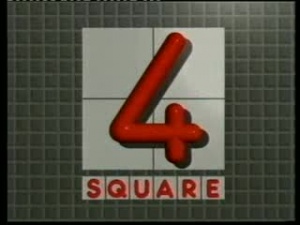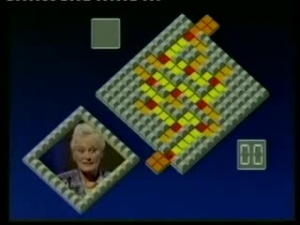Four Square
(→Trivia) |
Andywatson (Talk | contribs) (→Hunt the marzipan) |
||
| Line 53: | Line 53: | ||
===Hunt the marzipan=== | ===Hunt the marzipan=== | ||
| - | ''Pair the Squares'' was basically pelmanism back on the 6 x 6 grid - a game previously and simultaneously used on [[Concentration]] and later also on [[Memory Bank]]. This time behind the 36 squares were nine symbols, each one apparently appearing once in each quarter of the grid. The symbols were often given names by Sachs, like "marzipan" for a small 2x2 square (in retrospect, we reckon he meant "battenburg"), for easy recognition. One very recognisable symbol that was frequently used was the 'No Entry' sign. | + | ''Pair the Squares'' was basically pelmanism back on the 6 x 6 grid - a game previously and simultaneously used on [[Concentration]] and later also on [[Steal]] and [[Memory Bank]]. This time, behind the 36 squares were nine symbols, each one apparently appearing once in each quarter of the grid. The symbols were often given names by Sachs, like "marzipan" for a small 2x2 square (in retrospect, we reckon he meant "battenburg"), for easy recognition. One very recognisable symbol that was frequently used was the 'No Entry' sign. |
| - | Players fired a salvo of four squares on their go, each match earnt two points and turned the squares their colour, once again making a 4 Square | + | Players fired a salvo of four squares on their go, each match earnt two points and turned the squares their colour, once again making a 4 Square earned a five point bonus. The game ended when time ran out or when only two squares remained, as they had to match. |
Sachs' first set was a bit dark and warehousey and made no attempt to hide the fact they were basically playing on two 21 inch tellies someone had ran out and bought at Dixons, or something. Later series were much lighter, brighter and simultaneously more neon and more pastel. Lovely. | Sachs' first set was a bit dark and warehousey and made no attempt to hide the fact they were basically playing on two 21 inch tellies someone had ran out and bought at Dixons, or something. Later series were much lighter, brighter and simultaneously more neon and more pastel. Lovely. | ||
Revision as of 17:01, 8 March 2023
Contents |
Host
Michael Groth (1988)
John Sachs (1989-91)
Broadcast
BBC Pebble Mill for BBC1, 3 to 26 May 1988 (16 episodes in 1 series)
BBC Elstree for BBC1, 11 September 1989 to to 31 October 1991 (93 episodes in 3 series)
Synopsis
Rather jolly afternoon quiz with lashings of late eighties computer technology.
The first series is a bit of an oddity. Hosted by Michael Groth from That's Life!, two people played in single rounds where they would answer questions to turn squares on a board their colour. If they get four squares in a square block, that's a 4 Square and they won the game and got to take on The Maze for a prize. We don't remember much more than that, unfortunately.
Sach's Amazing
New series, new format, new set, new host.
In comes the smooth tone of TV and Radio's Mr. Überreassuring John Sachs as host. Now two people battle it out in a daily knockout competition of general knowledge, strategy, memory and co-ordination. The Krypton Factor it was not, however.
The points each player earned were banked, and the series winner got a chance to multiply them into 4 Square miles for a lovely holiday.
Three games were played each episode: The Grid, The Maze, and Pair the Squares. The order and rules these appeared were the same for every episode of a series, but between series the order and rules were often tweaked. Pair the Squares was usually split into two, pausing halfway through for one or both of the other rounds, but always ending the show.
In the Grid
Played on a 6 x 6 computerised grid of squares numbered 1 to 36, players took it in turn to call a number and answer a question based on a the subject of a picture that hid behind it. A correct answer earns a point and turns the square your colour. A wrong answer gave the point to the opponent and turned the square their colour. Four of the squares were randomly chosen to be "gremlins" - effectively booby-trapped squares that counted as an automatic wrong answer.
The goal was to try and get a block of four squares in square formation of your own colour. That was a 4 Square and earnt five bonus points and a lovely musical sting.
In early series this would continue until all the squares were used up, and each spinning square was accompanied by a rather irritating "bloop!". Happily later on the sound effect was dropped, and the round was sped up by letting both contestants take it in turns to place four free squares on the empty board and the round ending when no more 4 Squares were possible.
Literally amazing
The Maze was our favourite bit of the show. In effect, it was just a true or false quiz - Sachs read out statements, the contestant had to say the answer and also press the corresponding button on the desk in front of them, thereby testing co-ordination. Try and get 10 right in a minute, don't take more than five seconds to answer each one and each one is worth a point.
But what made it a little bit special was how it was played out, on an isometric computer maze not looking unlike an level from Crystal Castles, and doing it to one of the all-time classic bits of relentless clock music. A cursor would make its merry route along the route stopping at red junction boxes. If the player gives the right answer, the cursor would move along the correct path. If not, it would go down a "blind alley". If a player hit their button before the cursor hits a junction, it would move straight on but it won't move on until the player has hit the button or five seconds since the last question was asked. This could be quite important, in later series if both contestants made it through the maze, the player who did it quicker was given a ten point bonus question. In previous series everyone who completed it got the bonus. If there was one slightly jarring element to this round, it was the fact that contestants had to turn away from Sachs in order to face the maze, which seemed to go against the grain, given that in this country it's generally considered rude to face away from people when they're talking to you. Still, it's probably fair to say that it never really mattered, because the game and format worked as well as they did.
Hunt the marzipan
Pair the Squares was basically pelmanism back on the 6 x 6 grid - a game previously and simultaneously used on Concentration and later also on Steal and Memory Bank. This time, behind the 36 squares were nine symbols, each one apparently appearing once in each quarter of the grid. The symbols were often given names by Sachs, like "marzipan" for a small 2x2 square (in retrospect, we reckon he meant "battenburg"), for easy recognition. One very recognisable symbol that was frequently used was the 'No Entry' sign.
Players fired a salvo of four squares on their go, each match earnt two points and turned the squares their colour, once again making a 4 Square earned a five point bonus. The game ended when time ran out or when only two squares remained, as they had to match.
Sachs' first set was a bit dark and warehousey and made no attempt to hide the fact they were basically playing on two 21 inch tellies someone had ran out and bought at Dixons, or something. Later series were much lighter, brighter and simultaneously more neon and more pastel. Lovely.
Four Square was an affable little show, which brightened up many a dull lunchtime, arguably BBC Elstree in its golden age.
Key moments
John Sachs reading the scores out. Every two minutes.
Champions
1989 - John Mullings
1990 - Liz Gore
1991 - Rob Benbow
The 1988 series was individual shows, not a championship format.
Catchphrases
"And that's Four Square!"
"Pull up a chair for a game of Four Square."
"Turn to the maze, please..."
The Michael Groth version had a kind of Sale of the Century mechanic where the contestants earned an accumulated amount of points, and could either cash these in for prizes or refuse them and play another round for a higher value reward. This led to a catchphrase of stomach-churning naffness: "What a surprise, s/he doesn't want the prize!" - in fairness to Groth, probably not his fault, as he was no doubt just saying what he was told to say. Thankfully, this was dropped when the safe hands of Sachs came in.
Inventor
Toby Freeman
Theme music
The theme was writted by Ian McKim, who writes to UKGameshow Towers thus:
"I have only now found your site, and, as the composer of the theme and incidental music for all the series of programmes, thank you for the complimentary entry re: the maze theme. It was a difficult one to write to the exact time & to sound as intense and hurried as the producer Dave Ross wanted it.
"The music was recorded at Toad Hall Studios (now closed) in the south side of Glasgow. The original presenter was Michael Groth when it was filmed at BBC Birmingham initially, before it moved to Elstree. I think my name appeared in various forms on the credits."
Opening titles.
Trivia
There really is a game called Four Square. Check out Wikipedia for details. There was in fact quite a craze for that game in many British schools during the late 80s, almost simultaneously with the beginning of the quiz version.
The show was the very first 1.50pm slot replacement for Going for Gold when it wasn't on air.
Stephen Fry was a fan of the show. On the topic of British quiz shows, he once wrote: "I doubt if one in a thousand of you has ever pulled up a chair for a Four Square. Indeed it is probable that you do not know the origin of that inestimable phrase. This is a pity. I am not sure that one can ever understand this country and its citizens (stroke subjects) unless one knows that there are enough people living in it not only to watch these extraordinary programmes but also (and this is the truly remarkable fact) to participate in them as studio audiences and contestants."
Web links
Videos
An episode from 1989.
An episode from 1990.



